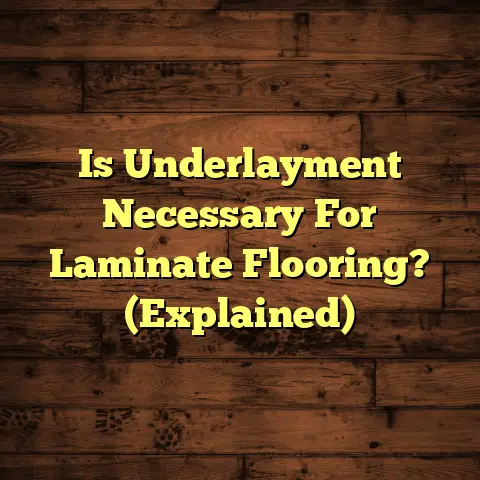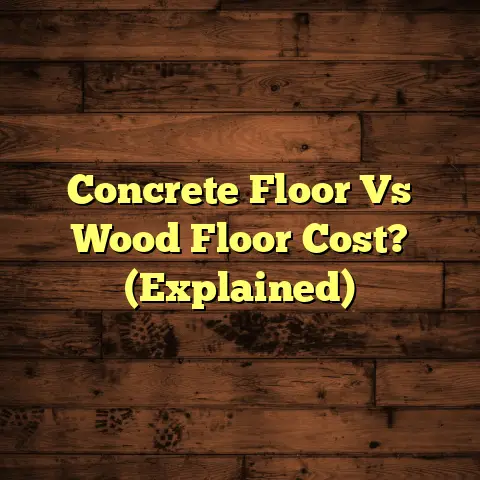Wood Floors & Underfloor Heat? (4 Install Fails!)
Navigating the Common Installation Pitfalls
Isn’t it a dream? Walking barefoot on warm wood floors during a chilly morning?
That’s the promise of wood floors paired with underfloor heating. It’s not just about aesthetics, but about upgrading your comfort level.
I’ve seen firsthand how this combination transforms homes. However, I’ve also seen the nightmares that arise when things go wrong.
That’s why I’m writing this “must-have” guide. I want to arm you with the knowledge to avoid costly mistakes. Let’s dive into the common installation fails that can turn your dream into a disaster.
Overview of Wood Floors and Underfloor Heating
Let’s break down the basics. When we talk about wood flooring, we’re not just talking about one thing. There are a few key types:
-
Solid Wood: This is the real deal. One solid piece of wood. It’s beautiful, but also the most susceptible to moisture and temperature changes.
-
Engineered Wood: Think of this as plywood with a veneer of real wood on top. It’s more stable than solid wood, making it a popular choice for underfloor heating.
-
Laminate: This is a synthetic material that mimics the look of wood. It’s durable and budget-friendly, but doesn’t have the same feel or value as real wood.
Now, about underfloor heating. There are two main types:
-
Electric: This uses electric cables or mats to generate heat. It’s generally easier to install, but can be more expensive to run.
-
Hydronic: This circulates warm water through pipes under the floor. It’s more energy-efficient in the long run, but the installation is more complex.
Why pair wood floors with underfloor heating?
Beyond the cozy factor, it’s about energy efficiency. Underfloor heating provides even heat distribution, meaning you can often set the thermostat lower than with traditional radiators and still feel comfortable. Plus, it frees up wall space and looks fantastic!
The Importance of Proper Installation
I can’t stress this enough: Proper installation is EVERYTHING. It’s the difference between a floor that lasts for decades and one that starts buckling within a year.
Wood is a natural material, and it reacts to its environment. The big issue here is thermal expansion and contraction.
Think about it: when the temperature rises, wood expands. When it drops, wood contracts. If you don’t account for this movement during installation, you’re asking for trouble.
Common Installation Fails
Okay, let’s get to the heart of the matter. Here are the most common installation fails I’ve seen, and how to avoid them:
Fail #1: Inadequate Moisture Control
Moisture is the enemy of wood floors, especially when you introduce heat. Wood is hygroscopic, meaning it absorbs and releases moisture from the air.
When you have underfloor heating, the temperature difference between the top and bottom of the wood can create a moisture gradient. This can lead to:
-
Warping: The wood starts to bend and twist out of shape.
-
Buckling: The wood planks lift up from the subfloor, creating an uneven and potentially dangerous surface.
I remember one project where a homeowner insisted on installing solid wood flooring over underfloor heating without properly acclimating the wood. Within months, the floor looked like a roller coaster!
What to do:
-
Acclimate the wood: This means allowing the wood to adjust to the temperature and humidity of the room before installation. Follow the manufacturer’s instructions carefully. Typically, this involves storing the wood in the room for several days or even weeks.
-
Measure moisture content: Use a moisture meter to check the moisture content of both the wood flooring and the subfloor. The difference between the two should be within the manufacturer’s recommended range.
-
Use a vapor barrier: Install a vapor barrier between the subfloor and the wood flooring to prevent moisture from rising up and damaging the wood.
Fail #2: Incorrect Temperature Settings
Think of your wood floor as a delicate ecosystem. Too much heat, and you’ll disrupt the balance.
Overheating wood floors can lead to:
-
Cracking: The wood dries out and develops cracks, especially along the grain.
-
Finish Damage: The finish can become brittle, peel, or discolor.
I once consulted on a project where the homeowner cranked up the underfloor heating to “get the house warm faster.” The result? A beautiful cherry wood floor that looked like it had been through a desert storm.
What to do:
-
Follow manufacturer’s guidelines: The flooring manufacturer will specify the maximum surface temperature for their product. Stick to it!
-
Use a thermostat with floor sensor: A floor sensor monitors the temperature of the floor itself, preventing it from overheating.
-
Gradually increase temperature: Don’t blast the heat right away. Gradually increase the temperature over several days to allow the wood to adjust.
-
Avoid rapid temperature changes: Sudden temperature fluctuations can stress the wood.
Fail #3: Poor Insulation
Imagine trying to heat your home with the windows open. That’s what it’s like having underfloor heating with poor insulation.
Proper insulation beneath the heating system is crucial for:
-
Efficiency: It prevents heat from escaping downwards, ensuring that more heat goes into your floor and your room.
-
Even Heating: It helps to distribute heat evenly across the floor, eliminating cold spots.
Without proper insulation, you’ll end up wasting energy and not getting the full benefit of your underfloor heating system.
What to do:
-
Use a high-quality insulation material: Rigid foam boards are a common choice.
-
Ensure proper coverage: Make sure the insulation covers the entire area beneath the heating system.
-
Consider the R-value: The R-value measures the insulation’s resistance to heat flow. The higher the R-value, the better the insulation. Check local building codes for minimum R-value requirements.
Fail #4: Neglecting Expansion Gaps
Remember that wood expands and contracts? Expansion gaps are your way of giving the wood room to breathe.
These are small gaps left around the perimeter of the room and at seams, allowing the wood to expand without putting pressure on the surrounding walls or other flooring.
Failing to leave adequate expansion gaps can lead to:
-
Buckling: The wood has nowhere to go when it expands, so it pushes upwards, causing the floor to buckle.
-
Damaged Walls: The pressure from the expanding wood can damage walls and baseboards.
I’ve seen floors that have literally pushed walls outwards because the installer didn’t leave enough room for expansion.
What to do:
-
Follow manufacturer’s recommendations: The flooring manufacturer will specify the required expansion gap size for their product. This is usually between ¼ inch and ½ inch.
-
Use spacers during installation: Spacers help you maintain consistent expansion gaps while you’re installing the floor.
-
Conceal the gaps: Use baseboards or quarter-round molding to cover the expansion gaps around the perimeter of the room.
Consequences of Installation Fails
Let’s be clear: these installation fails aren’t just minor inconveniences. They can have serious consequences.
-
Financial Implications: Repairing or replacing a damaged wood floor can be expensive. You’re talking about thousands of dollars in some cases.
-
Aesthetic Degradation: A warped, buckled, or cracked floor is an eyesore. It can ruin the entire look of your home.
-
Potential Safety Hazards: Uneven flooring can be a tripping hazard, especially for young children and the elderly.
I’ve heard countless stories from homeowners who regretted cutting corners on installation. Don’t let that be you.
Conclusion
Pairing wood floors with underfloor heating is a fantastic way to enhance your home’s comfort and beauty. But it’s not a project to be taken lightly.
Understanding the potential pitfalls and taking the necessary precautions is crucial to avoid costly errors. Remember, careful planning and execution are key.
Call to Action
Have you had any experiences with wood floors and underfloor heating? What challenges did you face? Share your stories and questions in the comments below!
And if you’re ever in doubt, don’t hesitate to seek professional advice. A qualified flooring contractor can help you navigate the complexities of this project and ensure a successful and satisfying result.
Remember, informed decision-making is the foundation of any successful home improvement project.





